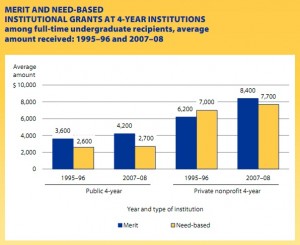Want A Merit-Based Scholarship? Go To A Private College

Kyle Stokes / StateImpact Indiana
Indiana's most famous private university, Notre Dame in South Bend.
Private four-year colleges are giving more merit-based financial aid to more students than public universities, and numbers from the federal government suggest the gap between the two has grown significantly in the last 15 years.
A report from the National Center for Education Statistics says 44 percent of all students received aid based on their academic performance at private schools in 2007-08. Compare that to 18 percent of students at four-year public schools.
It’s not completely surprising that private universities are able to give out more merit-based aid than public schools. Still, that disparity has grown since the 1995, when 24 percent of private university students received merit-based aid, compared to 8 percent of public university students.
The average private university student also received twice as much — $8,400 — as the average public university student, who receives $4,200.
According to the report, even students at the least selective private four-year universities were more likely to receive merit-based financial aid than students at the most selective public four-year universities.
The report comes as public universities in Indiana deal with shrinking state appropriations by hiking tuition — and students take on a bigger debt load to pay for school.
Indiana University president Michael McRobbie repeated the message that the school is offering more students financial aid, even as dwindling budgets force IU to tighten its belt. He acknowledged during his State of the University address, though, that higher tuition could drive students away. From the Indiana Daily Student:
“Not only could higher tuition rates price students out of a first-class education, but they could also price first-class education out of existence as the public increasingly turns to lower cost and lower quality options,” McRobbie said.
The reality, however, is that many of IU’s in-state students pay less-than-advertised tuition rates due to significant scholarship and grant aid.
“In fact, three out of four in-state students at IU Bloomington receive some form of financial aid,” McRobbie said.
